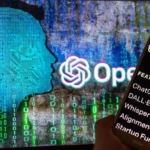AI News moved at full speed this week, and the pace felt different. From OpenAI quietly shipping GPT-5.1 to Google pushing new brain-inspired learning systems, the period from November 7 to 14 delivered one of the most intense stretches of progress so far. These updates are not small tweaks; they hint at a new phase for machines that reason, react, and learn over time.
This week’s AI News included models that adjust their thinking speed, agents that teach themselves new tools, and systems that mix text, images, and actions with surprising ease. As AI blends into everyday work, from creative teams to hospitals, these changes show how deeply it is sliding into how we create, review, and decide. If you care about where AI is heading, this is a week worth watching.
OpenAI’s GPT-5.1: Adaptive Reasoning For Enterprise Workflows
OpenAI skipped the big launch event and went straight to deployment. On November 11, rumors turned into reality when GPT-5.1 rolled out to Enterprise customers. Plus and Pro users started getting early access around November 12.
GPT-5.1 is not just a minor update. It changes how the model behaves in real time. Its standout feature is adaptive reasoning. The model switches between fast responses and slower, more methodical thinking, depending on how tough the request is.
Developer leaks claim it responds up to 57% faster on routine tasks, like text cleanup and summarization. For complex reasoning, multi-step analysis, or ethical questions, it intentionally takes longer and spends more compute, reportedly increasing deep thinking time by around 71%.
Picture a legal assistant powered by GPT-5.1. Ask it to check a basic contract clause, and you get an answer in seconds. Ask it to analyze a cross-border intellectual property dispute, and you see a different behavior. It pauses, runs through alternate scenarios, and offers a structured brief, with citations from your firm’s internal knowledge base.
Internally, OpenAI says its “intelligence per dollar” has improved around 40 times over the past year. That pace goes beyond rough comparisons to Moore’s Law that people like to use in AI News discussions. Still, critics are not satisfied. The company did not release fresh public benchmarks with GPT-5.1, and that gap fuels posts on X debating how much of this is real progress and how much is branding.
Early user reports suggest the impact is already large. Some finance teams say they cut compliance review timelines by about 40%. Creative agencies are using GPT-5.1 to spin up, test, and refine ad concepts in near real time.
Sam Altman hinted on a podcast that 2025 could be the year AI agents “join the workforce” in a serious way. He suggested they will handle entire workflows, like sourcing talent, screening candidates, and scheduling interviews, or rerouting supply chains when a key factory shuts down.
ChatGPT now has about 700 million weekly users and around $1 billion in monthly revenue. With GPT-5.1, OpenAI strengthens its lead and puts more stress on Anthropic, Meta, and other rivals. If GPT-5.1 performs as well as claimed, 2025 could feel like the year when AI stops being a simple assistant and turns into a partner that can anticipate needs.
Google’s Twin Moves: Human-Like Vision And Lifelong Learning
Google, steady as always, answered with two big research drops that could shift how AI sees and learns. The first is DeepMind’s “AligNet” project, revealed on November 13. The goal is to train vision models to group concepts more like humans do. Instead of rigid labels, the model learns soft clusters based on similarity judgments from people.
Traditional vision systems are good at tagging “dog” or “tree” in a photo. They do worse at “odd one out” tasks. For example, is a zebra closer to a horse or to a barcode pattern? To fix this, DeepMind built a dataset of more than 50,000 pairwise human comparisons, then trained student models to match those judgments.
Early results show AligNet-style models move about 25% closer to human perception patterns. That improves follow-up tasks such as medical image review and autonomous driving, where small misclassifications can cause real harm.
In one demo, an AligNet-tuned model scanned satellite imagery to flag urban heat islands. It grouped “asphalt-heavy zones” and similar patterns without explicit labels telling it what to look for. A DeepMind researcher on X summed it up as teaching AI to see “patterns we actually care about,” instead of raw pixels.
This work could also help accessibility. A tutor backed by AligNet-style perception might adapt examples to match how a dyslexic student “sees” equations or word problems, making lessons easier to follow.
The second big move is the Hope architecture from Google Research, announced on November 7. Hope treats a model as a nested stack of problem solvers. The idea is to let models learn new skills without wiping out old ones, a problem known as catastrophic forgetting.
With plain transformer models, fine-tuning on fresh data can erase prior knowledge. Hope addresses this by self-modifying and layering new capabilities like sedimentary layers in rock. Tests on language modeling and long-context reasoning show 15–20% gains over baselines while keeping about 95% of earlier knowledge.
The design borrows ideas from neuroscience, like hippocampal replay, where the brain reinforces older memories while learning new ones. Hope could sit under Gemini’s “Deep Research” mode, which pulls data from Gmail, Drive, and Search to give tailored answers.
People on X reacted quickly. One futurist called it “a big leap toward AI that learns like a brain” and collected hundreds of likes. Businesses see the appeal. Imagine an AI analyst that learns how your company handles quarterly reporting, then applies that knowledge each cycle without a full retrain.
There are tradeoffs. Running Hope at exascale is expensive, and Google has not shared when this will run in full production. For now, it looks like a strong research step, with real but still early business potential.
Agentic AI: From Codebases To Robots, Systems Take More Control
AI agents, the semi-autonomous systems that plan and act, took center stage in this week’s AI News. The message is clear: they are moving from research demos to real products.
Abacus.AI introduced DeepAgent on November 10. This system learns to use tools while it works, almost like a child figuring out new objects. In tests, DeepAgent learned unfamiliar APIs on the fly, for example, querying a CRM system midway through a task, and hit around 80% success on new tool use.
Its creators called this “a first real step toward autonomous reasoning,” and the claim sparked long breakdowns on X, where users examined how its self-teaching loops operate.
DeepMind followed with SIMA 2 on November 12. This agent upgrades itself using feedback from Gemini while training in simulated 3D worlds like Genie-3. It learned to generalize tactics, such as reusing “mining” skills from one game to “harvesting” crops in another. SIMA 2 made about 30% fewer transfer errors than previous versions.
Anthropic joined in with Project Fetch. In this setup, Claude acted as a lead developer, coordinating a robot-dog control system. It shipped working code about twice as fast as a human-only baseline and even created a natural language interface for controlling the robot.
OpenAI is also in the mix. It’s an Aardvark system, a GPT-5-based security agent launched on November 8, that watches enterprise networks and flags suspicious activity. Early numbers point to around 92% precision when spotting anomalies.
On the research side, new papers on arXiv, like “Scaling Agentic Organization” and “Constructive Mathematics at Scale,” propose ways to manage swarms of agents. The aim is to turn individual AI assistants into teams that can divide work, share state, and reach group decisions.
Robotics is getting about, too. EddyBuild released an open ecocentric dataset on November 11 that captures real factory environments. This kind of dataset can produce robots that behave in ways that match real industrial floors, instead of neat lab scenes. World Labs launched Marble, a tool that can build interactive 3D worlds from a single text prompt, which gives agents richer spaces to train in.
Investors are paying attention. Parallel raised a $100 million Series A, co-led by Kleiner Perkins, to build infrastructure for multi-agent systems. That kind of funding signals growing confidence that agent-based AI is not just hype.
Hardware And Health: The Engines Behind AI’s Surge
None of these advances work without serious hardware and new science. Nvidia reached a $5 trillion valuation on November 9. At the same time, it started shipping Blackwell chips to sovereign cloud providers in South Korea. These chips target “AI factories” and hint at future ties to quantum systems.
SoftBank sold a large stake in Nvidia for around $5.83 billion, cashing in on the run-up. On the research side, a Swedish group reported progress on atom-thin magnetic materials that could cut memory power use by about 90%, a shift that would matter for large model training costs.
Health tech also had a big moment. New AI systems can decode brain signals into text with around 85% accuracy as of November 9. That progress offers hope for people who have lost the ability to speak by pairing neural implants with AI decoders.
Purdue University introduced RAPTOR, a tool that inspects chips for defects without damaging them. It detects flaws with around 97.6% accuracy, which can save time and money in semiconductor production.
In the creative sector, Universal Music Group struck a deal with Stability AI. The partnership focuses on rights-safe music generation tools, trying to balance AI creativity with payments and control for artists and labels.
The Bigger Picture: Booms, Backlash, And Huge Bets
Amid the excitement, the wider story around AI grew more complex.
Reuters asked if AI is both a bubble and a breakthrough at once, pointing to the dot-com era and Cisco’s post-boom struggle as a cautionary tale for today’s valuations.
Concern over superintelligence remains strong. More than 850 researchers, executives, and public figures signed a call on October 22 to ban or restrict certain forms of superintelligent AI. That push kept echoing through discussions this week.
Regulation is slowly taking shape. India’s draft rules would require labels on synthetic media, with public feedback closing on November 6. The UK’s Financial Conduct Authority signed a deal with Singapore to coordinate on AI oversight for financial services. Child safety groups continued tests on how easily current models can generate abuse-related images, a sensitive topic with high stakes.
Big tech is still spending heavily. Meta’s Mark Zuckerberg promised to invest “hundreds of billions” into computing and formed a new Superintelligence Labs unit. Baidu pushed ERNIE-4.5-VL, tuned for enterprise vision-language tasks, in a bid to compete globally.
On the startup side, Cursor, an AI-powered IDE, doubled its valuation roughly every two weeks and reached around $100 million. That pace shows how much demand exists for developer tools that bake AI into daily coding work.
As 2025 moves toward its final stretch, this week’s AI News paints a clear picture. AI is no longer just a tool that waits for instructions. It is becoming a partner that reacts, learns, and, at times, surprises. The open question now is not whether AI will reshape work and society, but how people, companies, and governments choose to guide that shift. Stay tuned. At this rate, next week’s updates might be even bigger.















